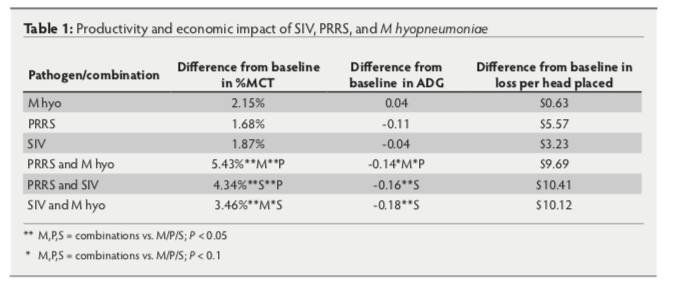Assessing production parameters and economic impact of swine influenza, PRRS and Mycoplasma hyopneumoniae on finishing pigs in a large production system
Introduction
Currently, publications are available that analyze the cost of porcine re- productive and respiratory syndrome (PRRS),1 but the cost of PRRS in combination with other common disease of swine is relatively unknown. The goal of this study was to link his- torical diagnostic reports with close out information in order to determine the production and economic impact of swine influenza virus (SIV), PRRS and Mycoplasma hyopneumoniae (M hyo) alone and in combination. The information generated can be used to make economically informed flow, production and vaccine decisions.
Materials and methods
Impact of disease in this study was measured as a difference from base- line in percent mortality, culls and tailenders (%MCT), average daily gain (ADG), and profit per head placed. Diagnostic reports, 2007- 2011, for SIV, PRRS and M. hyo cases from a large production system were matched to corresponding close out data. ADG and %MCT were obtained from the closeout reports. PPRS cases exposed to wild type virus and PCR positive were included re- gardless of PRRS vaccination status, and all pigs were vaccinated for M hyo. System baselines were established using average production numbers for sites in the production system that were previously categorized as high health sites. Baselines were calculated separately for nurseries, wean-to-fin- ish and finishing barns, as well as by year. Calculated baselines were com- pared to actual %MCT and ADG, and average difference from baseline was calculated. Costs per pig were determined using a wean-to-finish budgeting model (Dr. Holtkamp, Iowa State University). T-tests were run through Excel comparing un- complicated pathogens to the com- bination of pathogens. T-tests were used to determine if the increase in impact from individual diseases to combinations of pathogens was statistically significant.
Results
The results are shown in Table 1.
T Tests comparing %MCT from combinations to uncomplicated pathogens were all significant (P < 0.10). When comparing ADG all the data was found to be statistically significant (P < 0.10) except for SIV with M hyo compared to uncompli- cated M hyo, and PRRS with SIV compared to uncomplicated PRRS. The greatest numerical economic losses in each category occurred when pathogens were combined.
Discussion and conclusions
The additive cost of uncomplicated M hyo and SIV was $3.86, but the actual cost for this combination of pathogens was more than double that figure. Actual PRRS and M hyo costs were one and a half times greater when compared to the addi- tive costs of uncomplicated PRRS and M hyo. This data confirms that in this production system M hyo in combination with other pathogens produces more than additive losses in productivity. It is clearly demonstrat- ed that detrimental impact is greater when pathogens are combined. As a result, the production system in- volved, and the industry as a whole, can re-evaluate their pig flow, vac- cination protocols, and elimination strategies. Resources can be focused on eliminating risk of combined pathogens. The decisions they make moving forward as an industry will be economically informed and fo- cused on areas with the greatest im- pact on production and profit.
Acknowledgements
The authors would like to thank Dr. Todd Wolff, Steve Gilkerson, Patrick Weber, Art Halstead and Marty Chapman for their assistance collect- ing information and classifying sites. We would also like to thank Sarah Jorgensen for her work with histori- cal vaccine information. Lastly, we would like to acknowledge the work of Iowa State students Paul Thomas, Tess Bousema and Quinn Robinson for their assistance compiling historical data.

Reference
1. Neumann E, Kliebenstein J, Johnson C, et al. Assessment of the economic impact of porcine reproductive and respiratory syndrome on swine production in the United States. J Am Vet Med Assoc 2005;227(3):385–392.
